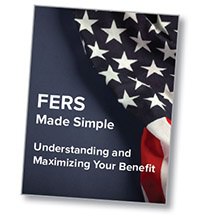Watch Out for These 7 Major FERS Retirement Mistakes
July 14th, 2021 | 4 min. read

According to the Employee Benefit Research Institute’s latest Retirement Confidence Survey, two-thirds of workers are confident they have enough to live comfortably in retirement. The same number of workers surveyed are confident they are doing a good job saving for retirement and know how much they will need.
But, only four in 10 workers have actually tried to calculate how much they need, which can be a costly mistake.
The difference in living a comfortable retirement is not only the things you do, but also the mistakes you avoid. While having a well-funded Thrift Savings Plan (TSP) account and FERS basic benefit are good reasons to be confident in the future, it helps to know how to sidestep potential financial pitfalls.
Here are the biggest FERS retirement mistakes federal workers should avoid.
1. Not reaching the full FERS basic benefit
Upon retirement, FERS will pay you a monthly benefit based upon your years of service worked under FERS, your income and the age you retire. As guaranteed income, you want as much as you are eligible for. That means earning unreduced benefits.
There are two eligibility options that affect the size of your basic benefit.
First, to be eligible for unreduced benefits (immediate retirement) you must meet one of the following criteria: must reach Minimum Retirement Age (“MRA”) (age 55-57, depending upon your year of birth) with 30 years of service; reach age 62 with 5 years of creditable service; or reach age 60 with 20 years of creditable service.
Second, employees can be eligible for early retirement if they have reached their MRA and have 10 years of service. However, those that elect early retirement will have their basic benefit permanently reduced by 5% for each year they retire before age 62.
Unless you suffer from a job loss or disability, that could be a significant amount of retirement income you don’t want to leave behind.
2. Not saving in your TSP up to your retirement date
New employees will, unless they opt out, automatically start their government career contributing 3% of their pay into the TSP as Traditional deferrals. Although this is a decent start, employees should increase their contributions to at least 5% to receive the most matching dollars possible.
As you approach your retirement date, it’s no time to take your foot off the gas. Instead, you should consider saving even more. At age 50, you are eligible to make catch-up contributions, which allow you to save an additional amount in your retirement accounts each year. You can save an additional $6,500, for a total of $26,000 (2021). Estimating the longevity of your retirement isn’t an exact science, so every extra dollar counts.
3. Overlooking health care needs and costs
Whereas many of your expenses decline once you retire, health care costs will generally rise as you age. A 65-year-old couple retiring today can expect to spend $295,000 on health care expenses in retirement, according to Fidelity’s Retiree Health Care Cost Estimate.
So, you want to be sure that you’re covered.
Retirees from FERS are allowed to maintain their Federal Employee Health Benefits (FEHB) coverage by paying through their FERS annuity, as long as they have been covered for at least the previous five years leading up to retirement. This is especially important to bridge the gap between retirement and Medicare eligibility at age 65. FEHB coverage can then be reduced or eliminated based on which Medicare or Medicare Advantage plan is chosen.
4. Investing too conservatively in your TSP
Conventional wisdom says you should invest more conservatively as you near retirement. That is, lower the amount of stocks in your portfolio to take some risk off the table. However, it’s possible to invest too cautiously.
Sure, you may not need the same level of growth in your portfolio. Yet, stocks, because of their higher growth potential, provide another important benefit to retirement investors: inflation protection. Assuming the historical rate of inflation of 3%, your money today could lose half its value in a little less than 25 years.
5. Choosing the wrong age to take Social Security
Along with your FERS basic benefit, Social Security is one of your guaranteed sources of retirement income. And just like your pension, you should carefully consider how best to use it based on your personal needs.
Many financial articles say it’s better to delay Social Security until age 70, which is when you can maximize your benefit. But there are good reasons for some people to claim Social Security early at age 62, even though it results in a permanently reduced benefit. You may have health issues that make it unreasonable to wait, or you may not want to spend down your retirement savings to make up for the income shortfall until you reach age 70.
Ultimately, factors such as your other income sources, marital status and health should guide your decision, not only when you can get the biggest Social Security paycheck.
6. Leaving your savings in your TSP
Upon retirement, there are several withdrawal options available to employees in which to use TSP savings to help fund your desired lifestyle. It is important to carefully choose your withdrawal options as well as your withdrawal amounts.
An IRA transfer is likely the best option for most retirees. That is, moving your TSP saving into an individual retirement account (IRA). Although the TSP offers solid investment options to grow your assets while still working, it may not provide the diversity, tax efficiency, investment selection and flexibility of an IRA that can better provide a reliable and sustainable stream of income throughout your retirement.
7. Retiring without a financial plan
To ensure you’re doing all the right things to live a comfortable retirement, get a financial plan that takes into consideration your assets, target retirement age, desired lifestyle and expected life span. It is all about creating the ideal conditions for your retirement.
For example, there are “best” days of the year to retire from FERS. The date you retire from FERS can carry significant importance based on your cash flow needs. Knowing those dates takes careful planning.
A financial plan will also detail how much to save and how to appropriately use your assets to create a sustainable income stream throughout retirement. Essentially, a financial plan will help you avoid all the potential FERS retirement mistakes above. For help, seek the help of a FERS-experienced financial adviser to make sure your plan is right for you.
Learn more about federal retirement benefits by downloading our free, easy-to-understand guidebook, FERS Made Simple: Understanding and Maximizing Your Benefit.
As a financial adviser, Kurt takes a comprehensive approach to help clients work toward their financial goals by providing wealth management tools including retirement planning, investment portfolio advice and tax strategies. He specializes in federal government benefits and is a Chartered Retirement Planning Counselor.


